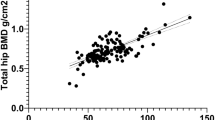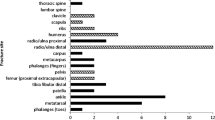Abstract:
The widespread availability of quantitative ultrasound (QUS) and X-ray absorptiometry densitometers raises the question of whether a combination of QUS and bone mineral density (BMD) measurements could provide a clinically useful method of enhancing the prediction of fracture risk. The aim of this study was to examine whether a combination of axial BMD and calcaneal QUS measurements can enhance fracture discrimination compared with either method alone. The study population consisted of 154 postmenopausal women with a history of atraumatic fracture at the spine, hip or forearm and 221 healthy postmenopausal women with no clinical risk factors for osteoporosis. Subjects had dual-energy X-ray absorptiometry (DXA) measurements of the lumbar spine (LS), femoral neck (FN) and total hip (THIP) and calcaneal broadband ultrasound attenuation (BUA) and speed of sound (SOS) measurements on the Hologic Sahara (SAH) and Osteometer DTUone (DTU). Z-scores were calculated using the mean and SD obtained from the healthy postmenopausal group. Logistic regression analysis yielded odds ratios for BMD measurements at the LS, FN and THIP of 2.2, 2.2 and 2.3, respectively. The odds ratios obtained for QUS measurements ranged from 2.5 for DTU BUA to 3.3 for SAH SOS. While these odds ratios for QUS measurements were higher than those obtained for BMD measurements, the differences were not statistically significant. When the odds ratios for QUS were adjusted for BMD at the spine and hip, the odds ratios remained significant in all cases indicating that QUS and BMD variables contribute independently to fracture discrimination. When the BMD-adjusted odds ratios were compared with those for QUS alone, they were slightly lower but not significantly so. When the QUS measurements were adjusted for THIP BMD, the odds ratios for QUS tended to be lower than when adjusted for LS and FN BMD. The Z-scores for each of the QUS measurement variables were combined with spine or hip Z-scores. Logistic regression analysis of the QUS and BMD combined Z-scores yielded slightly higher odds ratios of approximately 3.1 (compared with 2.9 obtained for QUS alone) and increases in the area under the curve of approximately 2%. However, these increases were not clinically significant. In conclusion, the combination of axial BMD and calcaneal QUS measurements did not significantly improve fracture discrimination compared with either method alone.
Similar content being viewed by others
Author information
Authors and Affiliations
Additional information
Received: 29 June 2000 / Accepted: 18 December 2000
Rights and permissions
About this article
Cite this article
Frost, M., Blake, G. & Fogelman, I. Does the Combination of Quantitative Ultrasound and Dual-Energy X-Ray Absorptiometry Improve Fracture Discrimination? . Osteoporos Int 12, 471–477 (2001). https://doi.org/10.1007/s001980170092
Issue Date:
DOI: https://doi.org/10.1007/s001980170092




